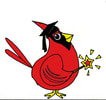|
|
|
|
|
Gioachino Antonio Rossini was born into a family of musicians in Pesaro, a town on the Adriatic coast of Italy that was then part of the Papal States. His father, Giuseppe, was a horn player and inspector of slaughterhouses. His mother, Anna, was a singer and a baker's daughter.
Rossini's father supported the French Revolution and welcomed Napoleon's troops when they arrived in northern Italy. When Austria restored the old regime, Rossini's father was sent to prison in 1799, where he remained until June 1800. Rossini's mother took him to Bologna (bo low nya), making a living as leading singer at various theatres of the Romagna region. Her husband would ultimately join her in Bologna. During this time, Rossini was frequently left in the care of his aging grandmother, who had difficulty supervising the boy. |
|
|
|
|
Gioachino Rossini was a talented composer, but he was also able to sing and play a few instruments as well.
By the age of 10, Rossini was able to read music, play the piano while other people sang, and sing solos in the church. By the age of 12, Rossini had discovered a love for composing music. In fact, by this time, he had already written six string sonatas to be played by 2 violins, a cello and a double bass. More impressively, he wrote them in only three days! |
|
|
|
|
Rossini has been called the most popular opera composer in history. He was one of the most renowned public figures of his time. A rapid and prolific composer, he was quoted as joking, "Give me the laundry list and I will even set that to music."
By the age of 21, Rossini had established himself as the idol of the Italian opera public. Two years later, he was named the musical director of two different theatres in Naples, Italy. Rossini started new trends all the time. One such trend was writing out the fancy notes of the arias instead of leaving them to the whim of the singers, and he was also the first to write a recitative accompanied by a string quartet. Do you remember what a recitative is? How about an aria? |
|
Today’s listening example is the famous aria sung by Figaro from “The Barber of Seville.” You may have heard this in a cartoon featuring Bugs Bunny. However, Rossini made this famous long before Bugs Bunny sang it. And by the way, he wrote this whole opera, in under three weeks. This opera is over 200 years old, but is still performed today by opera houses around the world.
|
|
|
|
|
Yesterday, we learned that Rossini wrote The Barber of Seville as a comedy opera, or opera buffa. Today we will learn about another kind of opera, operatic dramma giocoso, which means a dramatic opera with jokes
In December of 1816, Rossini was working in Rome, writing operas for the Teatro Valle. A celebration was coming up and he knew he needed something extraordinary to write about. The poet he was working with spent hours throwing out suggestions, but Rossini hated them all. Finally, between yawns, with Rossini half asleep on a sofa, the poet suggested Cinderella: Rossini stirred from slumber and challenged the poet named Ferretti, whether he had the courage to write a libretto on that story; Ferretti answered back challenging Rossini whether he was able to “clothe” it with his music. |
|
|
|
|
Rossini had a rather large ego, or a high opinion of himself. In fact, he named himself a maestro di cartello, which means a composer whose name along guarantees an audience.
Not only was Rossini full of himself, but he was extremely lazy! In fact, it is rumored that Rossini would compose in bed, and if a paper he was writing on dropped out of his reach, he would simply start all over! |
|
|
|
